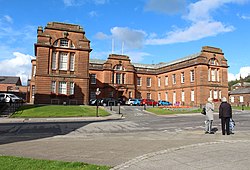County Buildings, Dumfries
| County Buildings, Dumfries | |
|---|---|
 County Buildings, Dumfries | |
| Location | English Street, Dumfries |
| Coordinates | 55°04′11″N 3°36′24″W / 55.0698°N 3.6067°W |
| Built | 1914 |
| Architect | John Dick Peddie and James Forbes Smith |
| Architectural style(s) | Renaissance Revival style |
Listed Building – Category B | |
| Official name | Dumfries County Buildings, 113 English Street, Dumfries |
| Designated | 21 August 1987 |
| Reference no. | LB26174 |
County Buildings is a municipal structure in English Street, Dumfries, Scotland. The structure, which is the headquarters of Dumfries and Galloway Council, is a Category B listed building.[1]
History
[edit]Following the implementation of the Local Government (Scotland) Act 1889, which established county councils in every county, the new county leaders decided to commission offices for Dumfriesshire County Council.[2] The site they selected formed the storehouse for the local militia barracks.[3] The main part of the old militia barracks, which was on an adjacent site to the southwest, was retained and incorporated into the new complex as additional office space.[4]
The foundation stone for the new building was laid in September 1912.[5][6] It was designed by John Dick Peddie and James Forbes Smith in the Renaissance Revival style, built in red ashlar stone at a cost of £21,000[7] and was completed in 1914.[1] The design involved a symmetrical main frontage with seven bays facing onto English Street with the end bays projected forward to form wings; the central bay, which slightly projected forward, featured a doorway flanked by brackets supporting a pediment. On the first floor there was a balustrade and a three-light window flanked by pilasters, and, at attic level, there was a gable containing a Diocletian window and a blind panel. Internally, the principal room was the council chamber at the rear of the building.[1]
Following the abolition of Dumfriesshire County Council, the complex became the headquarters of Dumfries and Galloway Regional Council in 1975,[8][9] and then, after the introduction of unitary authorities, it became the headquarters of Dumfries and Galloway Council in 1996.[10]
The Queensberry Monument, which was designed by Robert Adam in memory of Charles Douglas, 3rd Duke of Queensberry, was originally erected in Queensberry Square in 1780.[11] It was moved to the forecourt of the County Buildings in 1934 but then returned to Queensberry Square as part of a project to pedestrianise the area in 1990.[12]
See also
[edit]References
[edit]- ^ a b c Historic Environment Scotland. "Dumfries County Buildings, 113 English Street, Dumfries (LB26174)". Retrieved 16 August 2021.
- ^ Shennan, Hay (1892). Boundaries of Counties and Parishes in Scotland: as settled by the Boundary Commissioners under the Local Government (Scotland) Act, 1889. Edinburgh: William Green & Sons – via Internet Archive.
- ^ "Ordnance Survey Map". 1894. Retrieved 16 August 2021.
- ^ Smith, Mary; Kirk, Keith (2019). A-Z of Dumfries: Places-People-History. Amberley Publishing. ISBN 978-1445664729.
- ^ "Dumfries County Buildings". Dictionary of Scottish Architects. Retrieved 16 August 2021.
- ^ "Dumfries Conservation Area Character Appraisal and Management Plan" (PDF). Dumfries and Galloway Council. 1 May 2020. p. 10. Retrieved 16 August 2021.
- ^ "County Buildings". The Buildings News and Engineering Journal. 1911. p. 635.
- ^ "Local Government (Scotland) Act 1973". Legislation.gov.uk. Retrieved 16 April 2020.
- ^ "Leslie Carnegie". The Herald. 11 July 1998. Retrieved 16 August 2021.
- ^ "Local government facts and figures: Scotland". Local Government Information Unit. Retrieved 16 August 2021.
- ^ Historic Environment Scotland. "Queensberry Monument (LB26173)". Retrieved 16 August 2021.
- ^ "Queensberry Monument". Scotland Starts Here. Retrieved 16 August 2021.

